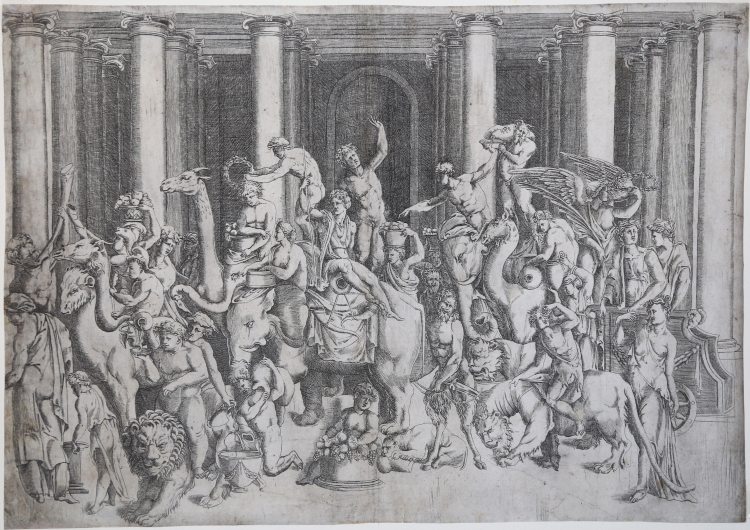



| Reference: | S41417 |
| Author | Enea VICO |
| Year: | 1542 ca. |
| Measures: | 465 x 330 mm |


| Reference: | S41417 |
| Author | Enea VICO |
| Year: | 1542 ca. |
| Measures: | 465 x 330 mm |
Engraving, 1542 circa, unlettered.
The scene, that shows Dionysos who rides in procession precede by captives on elephants and Dionysiac figures, is after a 2nd century AD Roman sarcophagus that was in the church of San Lorenzo fuori le mura by the end of the 15th century. Today it is installed in the Casino of Aurora in the Palazzo Rospigliosi, Rome.
According to the Census of Antique art known in the Renaissance, Vico’s is the only 16th-century engraving of this marble.
Bartsch says that there is a copy of Vico's engraving with “many changes” and two inscriptions on the bottom: “Paules de la Houue excud” and “Jachis crinali florens etc”. He also notes that Vico was so “negligent” that he didn’t finish the print and that it bears no inscription.
The engraving, as Massari notes (Iulio Bonasone, p. 81, n. 98) had been erroneously attributed by Cumberland to Giulio Bonasone. At the Uffizi (Gabinetto Disegno e Stampe, inv. 884) inventoried among Bonasone's prints is preserved another "Trionfo di Bacco" of Perin del Vaga's invention catalogued by Cumberland (n. 247) among the artist's engravings. The attribution to Giulio seems to us untenable on the basis of comparison with the analogous prints by Perin del Vaga, the style is in fact linked to Enea Vico who we identify as the author of the print.
Magnificent proof, printed on contemporary laid paper without watermark, irregularly trimmed at the copperplate, restoration in the left side of the sheet, small restored tear at the bottom center, traces of vertical fold visible on the verso, otherwise in good condition.
Rare work.
Literature
Bartsch, XV.297.32; TIB.30.47.32; Massari, Iulio Bonasone, p. 81, n. 98; Bodon, Enea Vico, pp. 70-71.
Enea VICO (Parma 1523 - Ferrara 1567)
|
Enea, son of Francesco, was antique dealer, drawer, engraver and numismatist. He was born in Parma on January 29th, 1523, according to what Huber says. After the first school years in the city, and very likely after he made acquaintance with the works of Giulio Romano, Vico moved to Rome in 1541. He then worked for Tommaso Barlacchi, who also engraved with him a series of Grottesche, in 1542. In the classical atmosphere of Rome, Vico’s style developed according to that of Perin del Vaga and Francesco Salviati, but always with Parmigianino as main reference. Around the first half of the century and after studying the works of Marcantonio, Agostino Veneziano, Caraglio and Bonasone, Vico acquired his own, peculiar style which can be seen in his main works. From Rome Vico moved to Florence, where he worked for Cosimo I, and then went to Venice, in 1557. In 1563 he is already in Ferrara, working for Alfonso d’Este till his death in 1567.
|
Enea VICO (Parma 1523 - Ferrara 1567)
|
Enea, son of Francesco, was antique dealer, drawer, engraver and numismatist. He was born in Parma on January 29th, 1523, according to what Huber says. After the first school years in the city, and very likely after he made acquaintance with the works of Giulio Romano, Vico moved to Rome in 1541. He then worked for Tommaso Barlacchi, who also engraved with him a series of Grottesche, in 1542. In the classical atmosphere of Rome, Vico’s style developed according to that of Perin del Vaga and Francesco Salviati, but always with Parmigianino as main reference. Around the first half of the century and after studying the works of Marcantonio, Agostino Veneziano, Caraglio and Bonasone, Vico acquired his own, peculiar style which can be seen in his main works. From Rome Vico moved to Florence, where he worked for Cosimo I, and then went to Venice, in 1557. In 1563 he is already in Ferrara, working for Alfonso d’Este till his death in 1567.
|